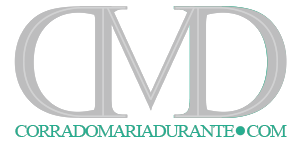What to do to avoid an ugly scar
- Moisturize morning and evening with Vitamin E gel or cream for the first 5-7 days
- Apply a thin sheet of Silicone gel (buying at the pharmacy) to put the night or day in relation to the anatomical area, for at least 4 months
- Silicone gel, in combination with sheet (day or night), for just 4 months
- Sunscreen (total protection) stick, cream or milk during daylight hours
- Avoid tight and dark clothing in contact with the scar.
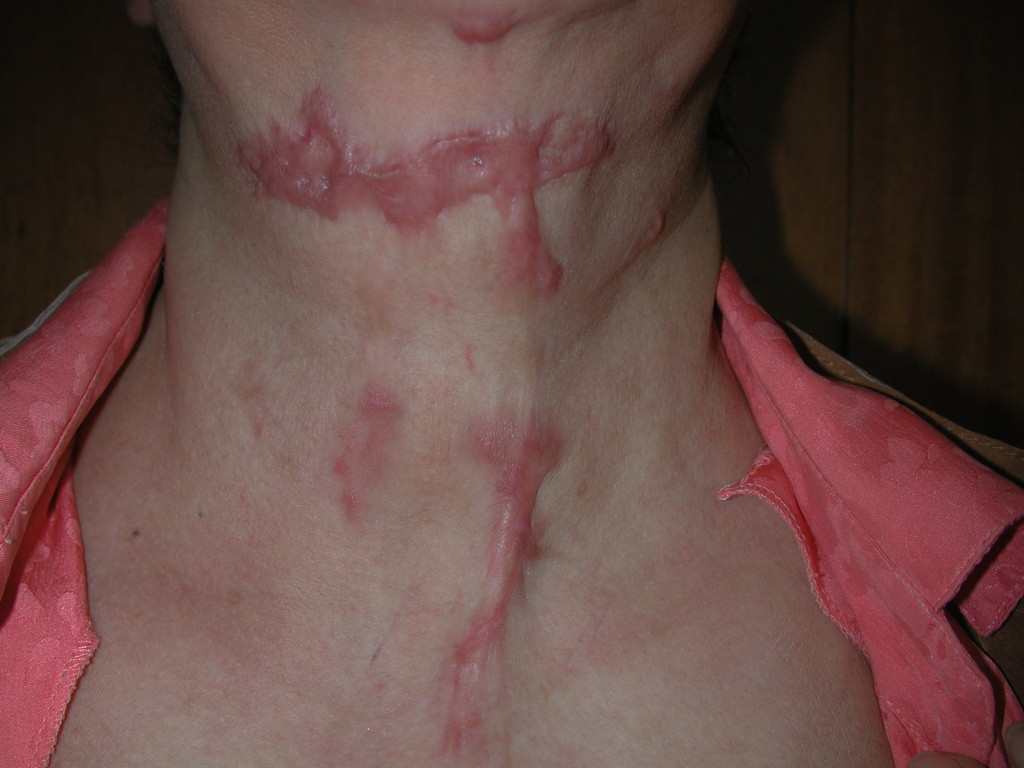
When to worry:
The first consideration, to treat and reduce skin scars is that these are not a disease, but the last stop of a long process that the body makes physiological toward healing the wounds that have stopped, significantly, our skin.
The scar is not the final product of the repair of an abrasion, a small cut or a light wound , but it is the culmination of the healing of deep wounds that have turned away, irreversibly, the edges of the injured skin affected.The scar is the missing piece, or rather removed from the trauma, of the skin puzzle that you are putting together; it physiologically corresponds to the precise size of the missing space, but its composition is not exactly identical to the piece to replace.
La piaga da decubito, meglio definita come lesione da pressione, è una ferita cutanea che si presenta a causa di un prolungato schiacciamento di una parte del corpo. La cute, compressa tra la prominenza ossea e una sporgenza esterna che può essere rappresentata da una materasso o dal cuscino di una sedia a rotella, non riceve quindi più un giusto flusso sanguigno.
The Latin origin “Cicatrix“, from the root “cingere” or tie around, suggests the intrinsic functional significance of the scar, which is to “renew” and make supportive the surrounding tissues unharmed and still be able to participate in the healing more complex wounds.
In summary then:
- the scar is an essential structural piece for wound repair but not exactly equal in its composition to the part who is going to replace;
- the mature scar, in fact, is fibrous and color appearance different from the surrounding skin, is not elastic and soft as the surrounding skin and often more sensitive to touch at least in the early days;
- the scar has no hair because it does not contain hair follicles, does not produce sweat because doesn’t show sweat glands and is more dry and sensitive because it contains no oil glands.
Despite these considerations, the physiological scar skin efficiently play its role as a “bridge” between the two edges of healthy tissue. The complete maturation of a physiological scar, which occurs after about 11-12 months after its appearance, it is crucial to be able to make conclusive therapeutic considerations and be certain to have averted the danger of a hypertrophic or keloid involution.
An important factor to remember, about the different composition and function of the scar piece, is the anatomical location of the scar; it essentially occurs after traumatic actions of a certain mechanical and thermal energy, the extremities (hands, feet, legs, arms, face, neck) are definitely more prone to injury than the rest of the body, however, scars are formed even after surgery.
GUIDE TO UNDERSTAND AND WORK ON SCARS:
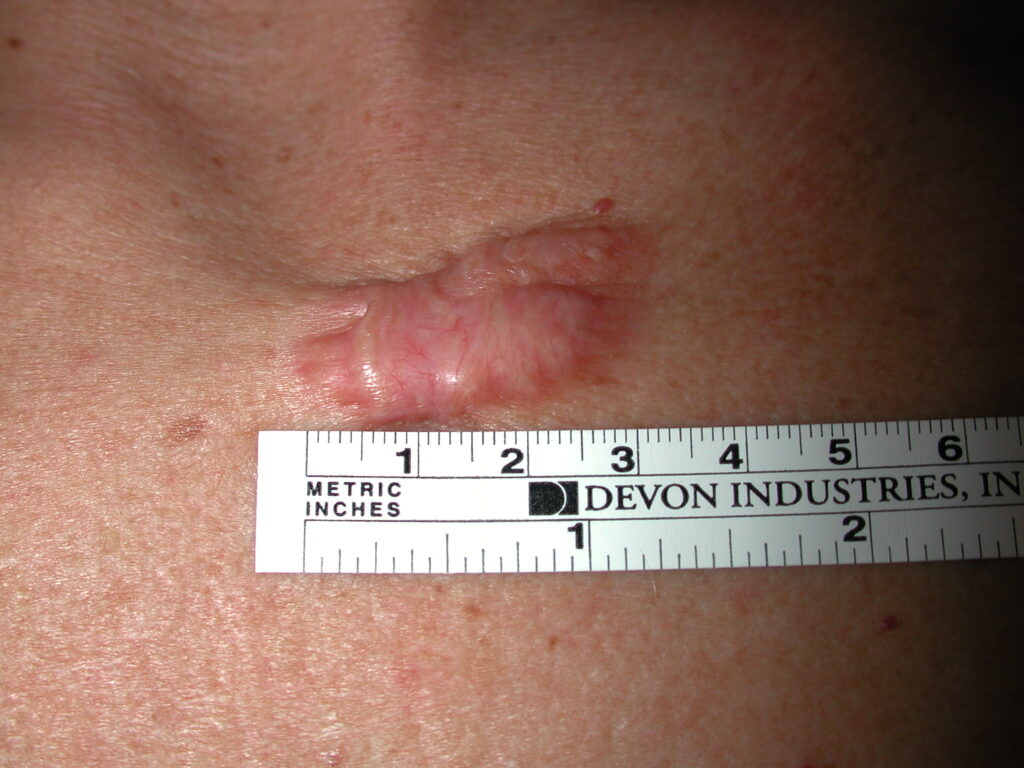
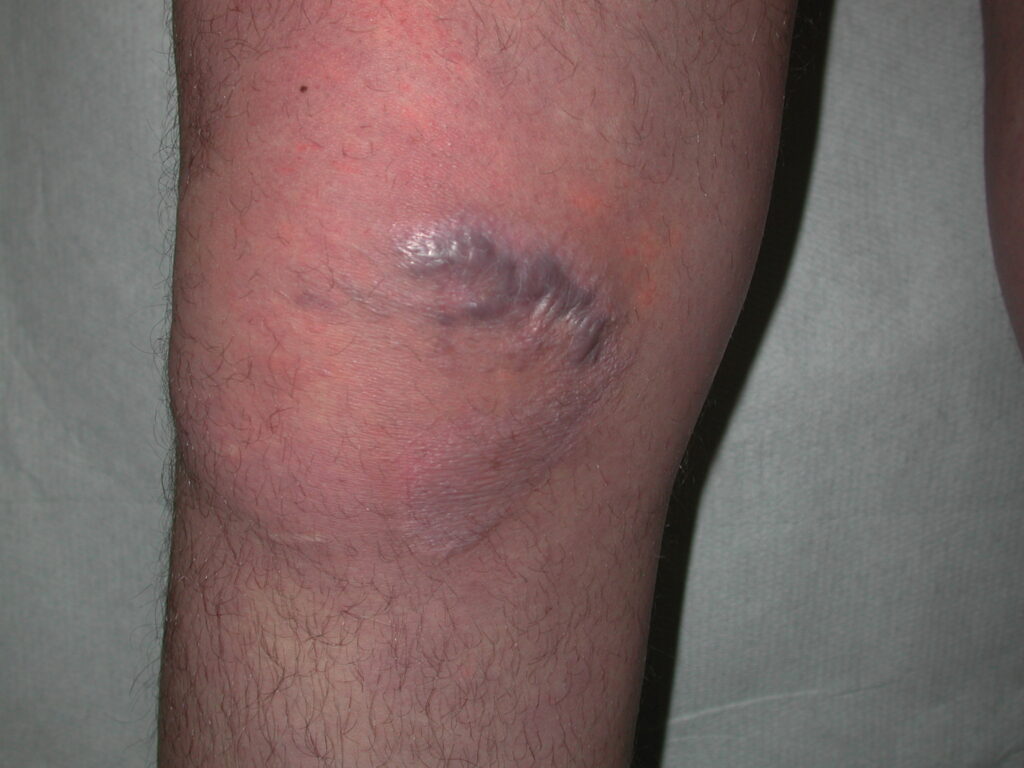
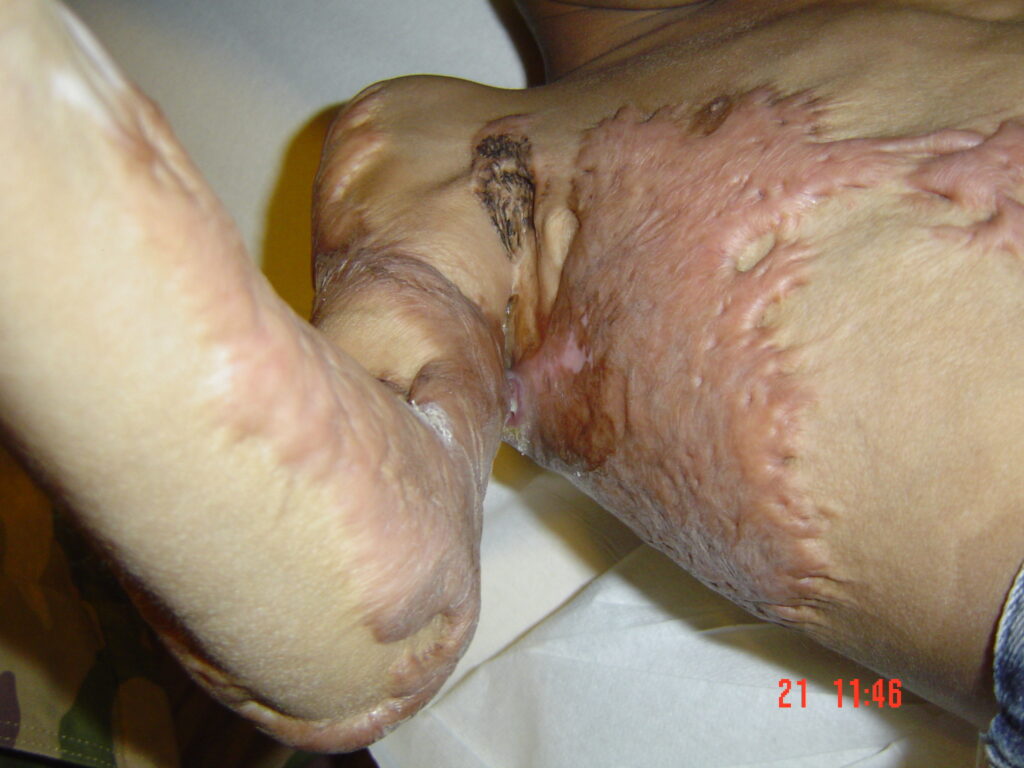
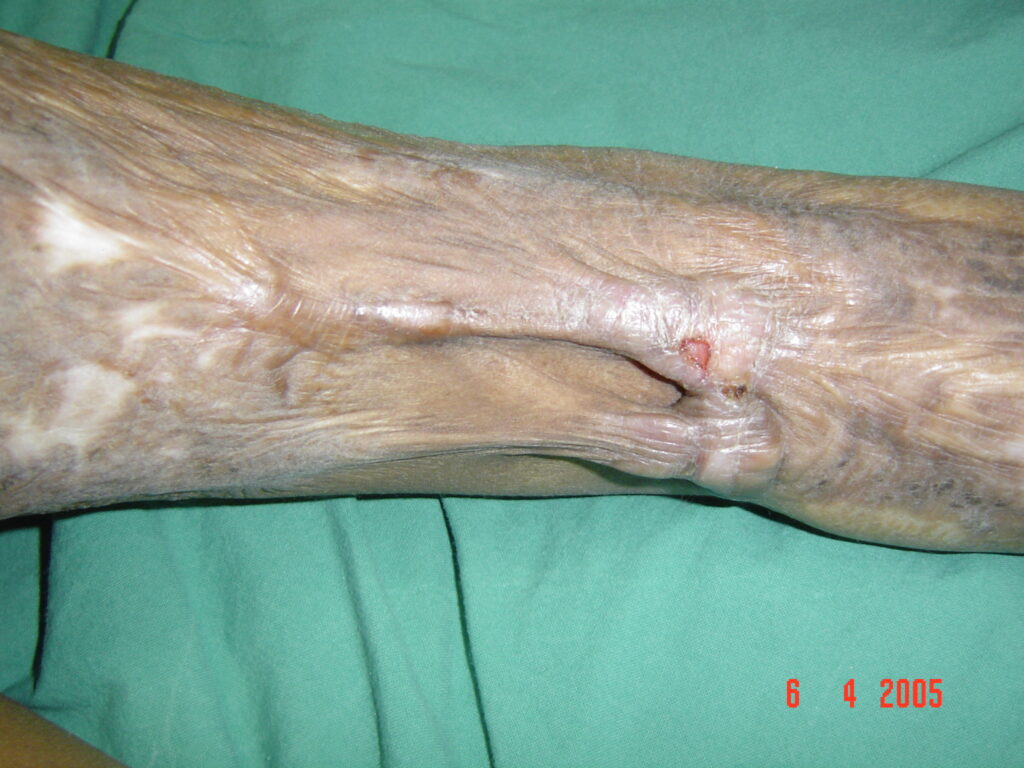
UNDERSTANDING THE SCARS
Clarified the concept that the scar is the last stage of a required physiological process, to achieve the healing of skin wounds, when produced by an important mechanical or thermal trauma; there are different interpretation of hypertrophic scars and keloids; the latter representing the outcome of an exuberant healing.
Normal scars
The scars are flat and perfectly corresponds to the same skin plane in the context of which are inserted;
Hypertrophic scars
Hypertrophic scars instead exceed the level of the surrounding skin, not going beyond the limits of the scar still physiological mature and this can sometimes constitutes criteria for the differential diagnosis with keloids. Hypertrophic scars are distinct from those immature (the life cycle of the scar should be follow, as mentioned, for 12 months) and are not significantly related to skin color or ethnicity of the affected persons ; usually develop in early maturation cycle and are often located close to the joints or the points of greatest skin traction;
Keloid scars
The keloid scars far exceed the limits of the mature scar, can deform the surrounding skin and cause skin retraction up to a distance of a few centimeters: the keloid, not only looks aesthetically foreign to anatomical area where it is located but, causes uncontrollable itching and sometimes pain: skin lesions from scratching as abrasions or superficial wounds are frequent complications of keloid. the sternum, the ear lobules , shoulders and cheeks are the most frequent localizations of keloid scars that sometimes share with hypertrophic scars too.
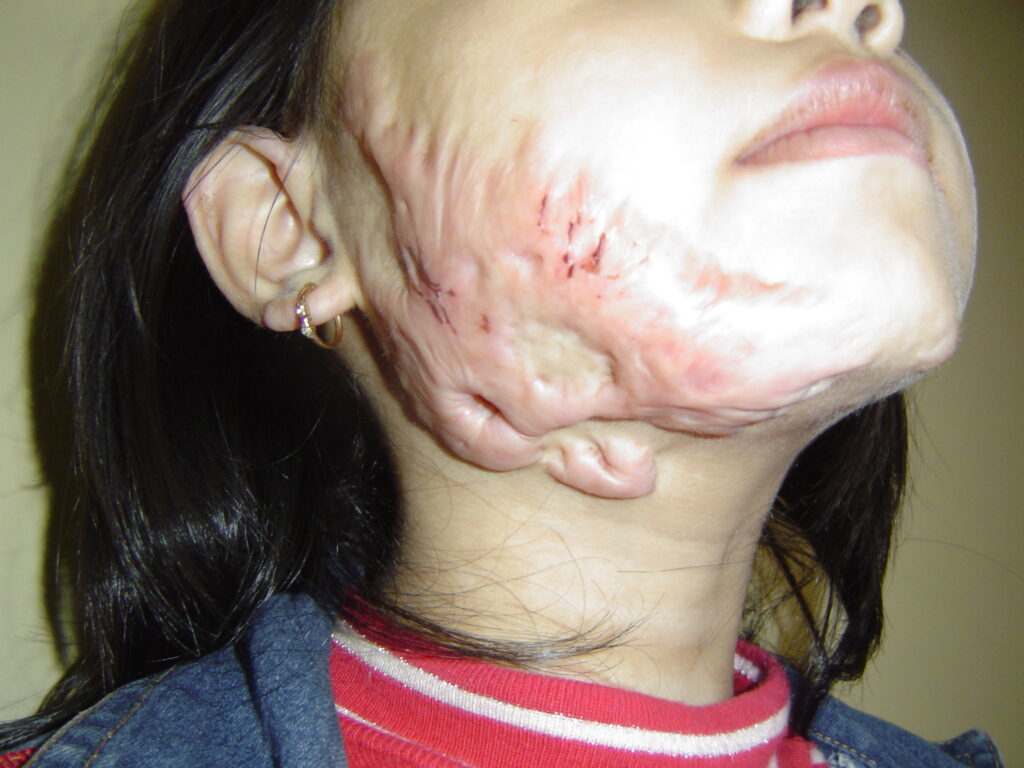
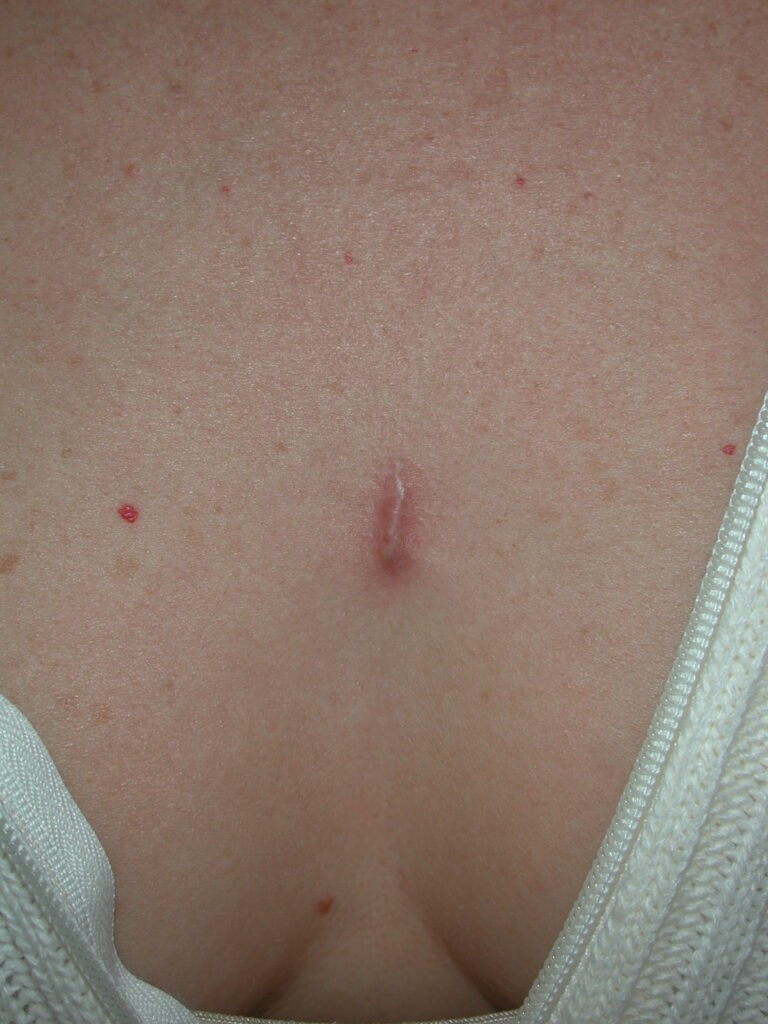
People at high risk of developing keloids are usually young (aged under 30 years) with dark skin, who have suffered major trauma not only as deep burns or infected wounds but also ear piercing or facial acne complex; even some immunizations (eg. anti-smallpox) and skin diseases may result in keloids.
The term “keloid” is derived from the ancient Greek that, due to the similarity with the “claw” crab, so defined it.
SCAR FOLLOW UP
The correct temporal control of a scar is therefore essential to assess:
- The maturational stage;
- Local preventive treatment;
- The onset of hypertrophic or keloid deviations;
The appropriate local therapy to prevent or delay the onset of abnormal drifts (hypertrophy / keloid), in some aspects, correspond to the treatment of the same complications. Therefore is reprehensible “forget” to advise the patient to the right “management” of its wound soon healed. The prescription of hygienic and therapeutic pronciples is therefore an “obligation” of the doctor who is in charge of the healing of a wound especially if:
- it has had a prolonged course or was the result of a particular trauma (eg. burn)
- if the patient is in color
- if it is localized in particular areas of the body
forgetfulness of therapeutic advice is even worse if all these occurrences are present simultaneously.
Proper surgical practice, the knowledge of the staging of scars (Vancouver Scar Scale), of the therapeutic panorama available and of the “Treatment Ladder” or the suitable correspondence between clinical stage and appropriate treatment, are the four pillars on which the strategy should be based on oppose the hypertrophic involution or keloid scar. The proper management of the scar could begin, therefore, already from the operating room or the first aid where the doctor has to choose the most suitable suture or skin reconstruction more fair for the wound that is repairing.
Currently there is a large and well documented scientific consensus towards the surgical tactics, the two opposing schools of thought are
- Derma well structured with numerous sutures + soft skin surface approach without tension.
- Minor component of foreign material in the dermis + more superficial stiches for holding the skin
and have not found a scientific literature (RCTs) can tip the balance in favor of one or the other. Indeed some clinical sector works advocate the use of biological glues for closing the outer plane, but the question remains on how to address the dermal plans without triggering an overreaction of the connective tissue (component predominantly in the dermis) with production of hypertrophic or keloid scars.
Given that there is no scientific evidence consistent on reconstructive procedures intended to prevent abnormal scar, not worth it to dig into the theories that base their results on different choice and use of suture material and the features of the needles to sew. Here it seems appropriate to propose only the lines of pure therapeutic orientation (still based on solid scientific literature) to dismiss the likelihood of a conversion of a scar skin into hypertrophic or keloid complications.
Scar treatment and associated syntoms
In principle, scar treatment, both in a “maintenance” and “prevention”, begins from the time of consolidation or since the scar is stable and has completely replaced the damaged tissue; the initial redness can return back to normal and in any case would disappear with the onset of therapy.
In the personal experience of managing complex wounds healed or in post-operative surgical sutures, I developed a management protocol that consists of several steps:
Thin sheets of silicone and vitamin E::
is the “first line” that I apply just after the consolidation of the scar; the dressing due to its texture and composition plays the first effects of hydration and occlusion; is maintained for about 10 days.
Sheets of silicone gel and silicone gel tube::
in 4-6 months following therapy approach, you have to apply these two protections; in relation to the habits / activities of the patient and the anatomical localization are divided, as needed, the two products in the day-night period (eg. gel sheets during night and day gel tube). In the absence of the cover sheet with silicone gel, is mandatory to avoid dark garments in contact with the scar, in the impossibility to avoid them, it is desirable to interpose a cut of fabric white linen or cotton; the silicone sheet appears to act by increasing the local skin temperature, favoring the hydration and the concentration of oxygen at the tissue, these three actions make the scar softer and flatter.
In deep burn scars , although corrected by dermal-epidermal grafts or skin flaps, in those large and located close to the joints or folds or on the hands and feet, I would recommend you to add compression garments, handcrafted custom built by specialized companies; pressure (24-30 mmHg) maintained for at least 6 months potentiates the effect of the sheets of silicone gel.
At this point when we have passed at least 6 months after the wound healing and we can evaluate the evolution of the scar with an eye to the season and to the weather situation; if you have achieved the goals of keeping the scar in his physiological development or with acceptable appearance, you can continue with only the silicone gel in the tube or with a simple specific cream / moisturizer oil , in combination with an appropriate sun protection if the season recommend it. In the event that, although it has put in place all the precautionary measures, the scar has assumed hypertrophic or keloid aspect, you will need to switch to “light second line” therapeutic.
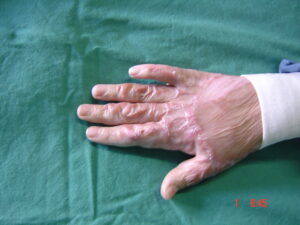
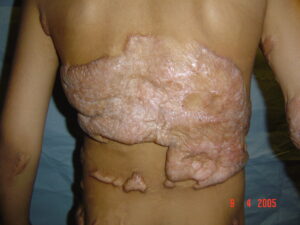
People at high risk of developing keloids are usually young (aged under 30 years) with dark skin, who have suffered major trauma not only as deep burns or infected wounds but also ear piercing or facial acne complex; even some immunizations (eg. anti-smallpox) and skin diseases may result in keloids.
The term “keloid” is derived from the ancient Greek that, due to the similarity with the “claw” crab, so defined it.
Local infiltration of corticosteroids:
Triamcinolone acetonide injected in the context of the scar, carrying anti-inflammatory, antimitotic and vasoconstrictor effects, seems to stop the decline of hypertrophic lesion. Intralesional infiltration (prepared with a few cc. of anesthetic) is performed every 3 weeks, with a special technique that takes into account the length and apparent thickness of the scar to space in a balanced introduction.
Reduction of redness and flattening of the scar are the first results (sometimes partial) of the mixture of Triamcinolone acetonide; Treatment should be continued for at least 4-6 months and must be effectively monitored so as to avoid or reduce the side effects of corticosteroid, such as skin atrophy, telangiectasias, and hypopigmentation local.
Combination therapies:
failure to control of scar keloid involution, obliges the doctor to take action more invasive and combined . Although the complete maturation of the scar lasts about 12 months, a clear examination of keloid formation advised the doctor to reset the process and start from scratch: the surgical treatment associated with concomitant corticosteroid therapy and possibly local cryotherapy, is the “second strong line “.
The keloid, usually infiltrates neighboring healthy tissue, attracting and involving them in the phenomena of skin retraction that, close to the joints, can determine actual functional limitations. The surgeon must take account of this “derangement” of the tissue, and prepare a plan for alternative demolition and reconstruction; surgery alone, almost always losing against recurrent keloid which sometimes are even more invasive and monstrous of the past, must be associated with infiltration of corticosteroid, to be made in the same surgical time and programmed at successive times.
Sessions of targeted radiotherapy, in experienced hands, can be an effective complementary therapy to surgery. Starting from scratch, you will need to apply immediately a sheet of silicone gel 24 hours a day (attention to allergies) and a meticulous follow-up.
Recent evidence shows that treatment with Pulsed Dye Laser, application of Imiquimod 5% cream, local infiltration of Verapamil, Fluorouracil or Bleomycin, can be a “second line” treatment alternative to the methods described above, although in need of further and broader clinical studies.
Especially in extensive and deep burn scars, despite the application of all the preventive rules reported, the itch remains a formidable enemy. The annihilation of the sebaceous glands, sweat glands and hair follicles causes a “desert” transformation of the scar; worsening dryness brings a feeling of hardening of the skin surface that triggers the desire to scratch.
Often systemic therapy with antihistamines are not enough to alleviate the itching, because it is not only involved the inflammatory cascade of histamine, homeopathic therapies orally could play some soothing, but the main treatment is based on the use of soaps oily solutions and moisturizers specific, avoiding the use of mineral oil and lanolin products that are highly allergenic.
email me
The site quickly reached a consistent number of daily visits. To thank you, give you a tool for health and well-being and resolve your difficult-to-heal wounds, I offer you a completely free consultation. Vi offro un consulto completamente gratuito.
To book, fill out the form or call 06 899 286
